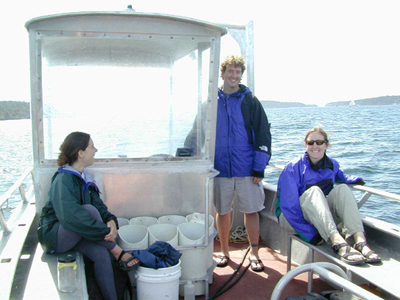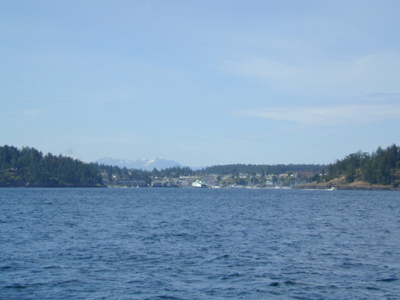Concluding
Thoughts
We observed so much
in the short space of a week -- darting copepods and copepod-like forms,
gently floating jellies, neatly geometric phytoplankton and enigmatic fish
and invertebrate eggs. At first the diversity overwhelmed us.
Then we began to see the same forms time and again, and to recognize the
movements of certain creatures. We tried to capture these forms and
movements. Our pictures pale a bit in comparison to those taken by
seasoned professionals, but through the process of trying to cast the best
light on our subjects and to understand how plankton make their livings,
we learned a great deal about what is involved in studying animals in the
plankton.

Much can be learned
through careful sorting and observation of planktonic organisms, provided
one has a couple of key field guides, a simple microscope, and patience
to keep looking. As we sampled the plankton with different nets and
at different times of day, we gained hints of the multitude of environmental
factors that shape the distribution and abundances of planktonic organisms.
We caught copepods in great numbers during the day, while we lured more
crab zoea than we ever wanted during the night-lit vertical tow from the
FHL docks. Jellies seemed more abundant in areas where slicks occurred--places
where currents concentrate larvae and other organic material at the water's
surface. Ctenophores were not abundant, but seemed more often caught
during the day. We did not find any echinoderm larvae in our samples,
but are uncertain whether that was due to their relative rarity or their
small size.

To document trends
in diversity and abundance in response to environmental cues, we would
want to sample over a greater time period and in replicated areas.
We would need to quantify the amount of water sampled during each tow,
and to consider known influential factors, such as time of day or tidal
stage, in our sampling design and analysis. Now that we have gained
some skills identifying planktonic organisms and operating the equipment
needed to sample them, it would be interesting to pursue specific questions,
such as:
-
How does the plankton
species assemblage in the vicinity of Friday Harbor vary with the tidal
cycle?
-
Do the assemblages sampled
at various depths differ?
-
Do the types or abundances
of organisms found in areas with and without slicks differ?
-
What mechanisms, such
as passive transport within tidal bores, predation avoidance, or vertical
migration, or some combination of factors, account for the observed patterns?
-
How do plankton assemblages
in this area change seasonally and annually?
These questions could
quickly escape the realm of reasonable projects, but with some practice
identifying plankton and fair knowledge of local currents and seasonal
cycles, both of which can be gained through practice and conversation at
FHL, some very interesting short studies could be done.
Acknowledgments
We would like to
thank our instructors - Mike Hart, Bob Podolsky, Marney Pratt, and Russell
Wyeth - for their enthusiastic and helpful input. Additional thanks
to Margaret for contributing much-needed photos, to Tom for his Clione
video and information, to Darren for marine support, and to the FHL staff
for logistical support. Our classmates good-naturedly shared computers,
meals and the invertebrate course experience, and for that we thank them.
Plankton
Home Annelida
Arthropoda
Chaetognatha
Chordata
Cnidaria & Ctenophora
Echinodermata
Mollusca
Invertebrates
2000
